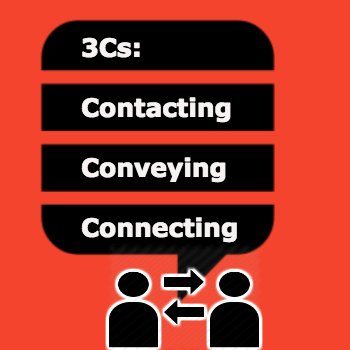Thinking Globally, Composing Locally.
An Interview with Kirk St. Amant & Rich Rice, by Gustav Verhulsdonck
3Cs Approach: You use the "3Cs of writing in global online contexts" to identify an approach for using online media to compose for international audiences. The 3Cs are three interconnected processes of "contacting, conveying, and connecting" an audience. How did you arrive at this idea and how does it work? What do you see as the benefit of the 3Cs approach for the audience of Kairos?
"Yes, contact, convey, and connect. The framework works very well for readers of Kairos, and the 3Cs forefronts the importance of principles of intercultural communication. Kairos is saying the right thing (contact), in the right way (convey), at the right time (connect)."
-Rich Rice

RICH:
Yes, contact, convey, and connect. The framework works very well for readers of Kairos, and the 3Cs forefronts the importance of principles of intercultural communication. I think we arrived at the 3Cs by trying to decipher where miscommunication happens. It happens when people don't make good contact, when they don't convey information well, and when they fail to connect well to an audience.
You know, we often tell our students that kairos is saying the right thing in the right amount at the right time. It's timeliness. It's more than appeal; it's a situation. How do you know what the right thing to relate is unless you first make contact? This reminds me of the film Arrival. The first step in interpreting the language of an alien visitor is in making contact, demonstrating that attempts to communicate are not aggressive or threatening but are presented to create understanding. The main character in the film realizes that and, ultimately, develops a communication system. Translation and technical communication are two sides of the same coin. As Kirk says, contacting isn't random. We can no longer cast a wide net when trying to reach an audience in an effective way because every audience has specific and complex needs. It involves understanding an audience's perspectives and viewpoints without making judgements, figuring out what attributes or characteristics the decision-makers within the intended audience may have, and learning what they know and don't know. What rhetorical moves are there are as option, and which of those moves are likely to have the most effective impact. To know what the right thing is in order to achieve kairos first includes making contact.
"I like to say that composition is becoming more "tech commie," which is to say that more and more attention is being paid to genre."

Once one has a good idea about what the right thing to say might be, what we call "contact," the right amount or modality must be examined. Close consideration of how to share that information, or what we call "convey," is needed. I like to say that composition is becoming more "tech commie," which is to say that more and more attention is being paid to genre (consider the dichotomy Richard Lanham (2005) calls "fluff vs. stuff"); attention to the medium as opposed to just the message. The medium and the message is the message. How something is conveyed is perhaps as important as what is conveyed in an economy of attention. Of course, contact and convey overlap in principle, because to know what should be conveyed includes an audience analysis that also informs how best the receiver might effectively benefit from what is being conveyed. Just as both the medium and the message is the message, the "what" and the "how" must be closely considered as an integrated scheme. Saying the right thing in the right amount or way is not as one-dimensional as it used to be.
Finally, connect, the third component in the framework, is akin to "at the right time." Kairos is saying the right thing (contact), in the right way (convey), at the right time (connect). I often relate this point drawing upon something I wrote for Kairos years ago when I started teaching classical rhetoric. For Aristotle, inventio wasn't coming up with something new, inventing a new process or product. It was more like selection or knowing how to choose the most appropriate approach or piece of information for a rhetorical situation. When I search Google for something, which I often do now by clicking images, I'm not inventing anything other than using Google to prioritize for myself what's out there. And what I search for is what I'm interested in at the time, but that can change, and often does, as I change search terms. Knowing what I have to choose from, given many different situations, given different friction points or problems leading to stasis or common ground with any given audience, is what makes a good rhetorician. It's what connects or resonates most, and knowing how to present that content in just the right way at the right time—that I liken to timeliness. Of course, this includes connecting to a cultural appeal or set of core values given a specific culture or organization.
Composing with online media involves an investigative process of audience that involves these three steps of contacting, conveying, and connecting. I've always been impressed by the journal's exploration of what native hypertext can do. What can be done through a modality when the conception of what can be done starts in hypertext rather than in print? Like Lev Manovich (2001) said, new media genres include variation; as George Landow (2007) said, hypertext reading experience is multisequential rather than nonlinear. There is a line. There are many lines. We have to teach students how to predict effective lines of communication for varied readerships. Find a way to make contact. Think carefully about what and how that something should be conveyed. Do so in an active manner that promotes change through connecting effectively with varied audiences, even if that change is meant to be "information-only."
Yes, contact, convey, connect is a useful framework. #interculturally-applied-kairos
Top of the page Location and Medium
—webtext & interview by Gustav Verhulsdonck 2017
